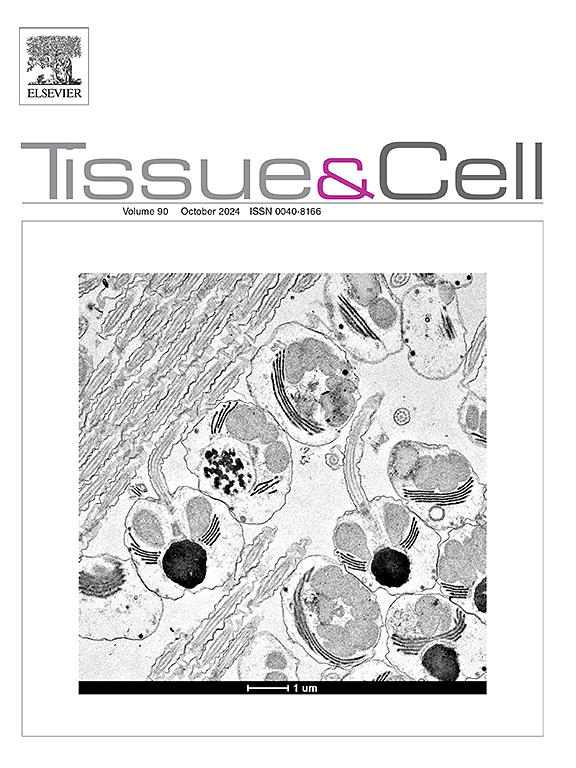轻度产前lps诱导炎症和产后应激对成年雄性小鼠前额皮质突触可塑性和神经免疫反应的影响
IF 2.7
4区 生物学
Q1 ANATOMY & MORPHOLOGY
引用次数: 0
摘要
据报道,仅轻度母体免疫激活(MIA)对新生儿大脑的影响很小,但当与产后应激(PS)结合时,它可以引发显著且持久的神经发育变化。本研究探讨了MIA单独或联合PS对前额叶皮层突触可塑性和分子通路的影响,并重点研究了其与神经发育障碍的潜在联系。妊娠小鼠于妊娠第17天(GD17)腹腔注射脂多糖(LPS, 50 μg/kg)或无菌生理盐水。子代在出生后30-38天分别受到青春期前应激和无应激。在出生后第56 天,每窝随机选择2只雄性幼崽(每组共n = 6只)进行前额叶皮质分析。进行组织、结构和分子分析,包括免疫组织化学和基因表达分析。与LPS、应激对照组相比,LPS+应激组星形胶质细胞相关突触细胞显著减少(P <; 0.05)。与其他各组相比,LPS+应激组突触可塑性相关蛋白和基因(BDNF、GAP-43、N-cadherin、synapin -1和GFAP)的表达水平显著降低(P <; 0.05)。虽然MIA和PS单独诱导细微的突触和炎症变化,但它们的联合作用被显著放大,导致对突触功能至关重要的分子表达异常。这些发现表明,轻度MIA和PS的联合作用可能加剧突触和炎症失调,潜在地增加对神经发育障碍的易感性。未来的研究应探索潜在的治疗策略,以减轻MIA和PS对神经发育的协同作用。本文章由计算机程序翻译,如有差异,请以英文原文为准。
Impact of mild prenatal LPS-induced inflammation and postnatal stress on synaptic plasticity and neuroimmune responses in the prefrontal cortex of adult male mice
Mild maternal immune activation (MIA) alone has been reported to exert minimal effects on the newborn brain, but when combined with postnatal stress (PS), it can trigger significant and, lasting neuro developmental changes. This study investigated the effects of MIA, alone and in combination with PS, on synaptic plasticity and molecular pathways in the prefrontal cortex, with a focus on potential links to neurodevelopmental disorders. Pregnant mice received an intraperitoneal injection of lipopolysaccharide (LPS, 50 μg/kg) or sterile normal saline on gestational day 17 (GD17). Offspring were exposed to prepubertal stress or no stress from postnatal days 30–38. Two male pups per litter (totally n = 6/ per group) were randomly selected at postnatal day 56 day for prefrontal cortex analysis. Histological, structural, and molecular analyses were conducted, including immunohistochemistry and gene expression analysis. The LPS+Stress group revealed a significant (P < 0.05) reduction in astrocyte-related synaptic cells compared with the LPS, stress control groups. Expression levels of synaptic plasticity-related proteins and genes (BDNF, GAP-43, N-cadherin, synapsin-1, and GFAP) were significantly (P < 0.05) reduced in the LPS+Stress group compared to all other groups. While MIA and PS independently induced subtle synaptic and inflammatory changes, their combined effects were significantly amplified, leading to aberrant molecular expression critical for synaptic function. These findings suggest that the combined effects of mild MIA and PS may exacerbate synaptic and inflammatory dysregulation, potentially increasing susceptibility to neurodevelopmental disorders. Future research should explore potential therapeutic strategies to mitigate the synergistic effects of MIA and PS on neurodevelopment.
求助全文
通过发布文献求助,成功后即可免费获取论文全文。
去求助
来源期刊

Tissue & cell
医学-解剖学与形态学
CiteScore
3.90
自引率
0.00%
发文量
234
期刊介绍:
Tissue and Cell is devoted to original research on the organization of cells, subcellular and extracellular components at all levels, including the grouping and interrelations of cells in tissues and organs. The journal encourages submission of ultrastructural studies that provide novel insights into structure, function and physiology of cells and tissues, in health and disease. Bioengineering and stem cells studies focused on the description of morphological and/or histological data are also welcomed.
Studies investigating the effect of compounds and/or substances on structure of cells and tissues are generally outside the scope of this journal. For consideration, studies should contain a clear rationale on the use of (a) given substance(s), have a compelling morphological and structural focus and present novel incremental findings from previous literature.
 求助内容:
求助内容: 应助结果提醒方式:
应助结果提醒方式:


